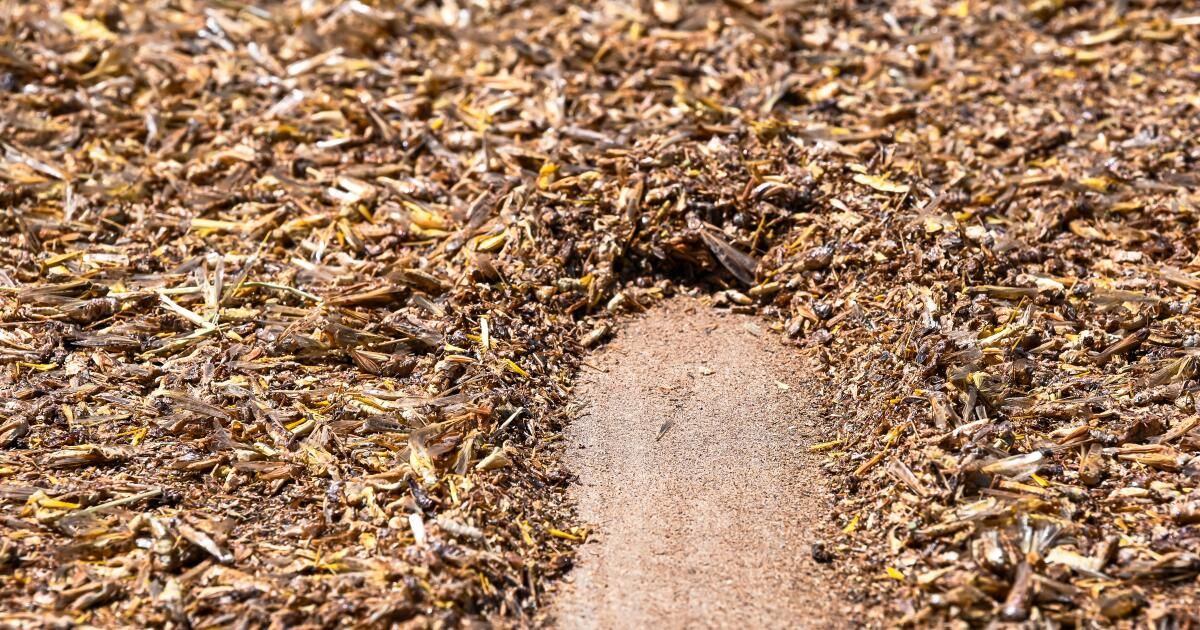When a torrent of grasshoppers devoured more than 100,000 acres of grassland and pasture three years ago in the northeast part of the state, Mike McKoen felt bad for the ranchers who took a financial hit. But the third-generation farmer didn't worry much about his family farm, where they grow crops like onions, potatoes and wheat.
“They don’t like onions,” an entomologist told him about grasshoppers. He explained that the insect prefers to feed on dry, unirrigated land where cattle graze.
But last year, swarms of grasshoppers attacked McKoen's onions. They chewed through the stems and left holes where irrigation water leaked, leading to the spread of fungal and bacterial diseases. He spent nearly $100,000 to rescue his crops.
Hundreds of farmers and ranchers lost much of their crops, causing millions of dollars in damage, scientists and government officials said.
Now, grasshoppers, which can travel long distances and decimate crops in their wake, are making another unwelcome appearance in the state's northern reaches.
“The grasshopper population in the region has increased in size, range and density in recent years,” said Rob Wilson, natural resources and livestock advisor for the University of California Cooperative Extension in Tulelake.
Wilson, who specializes in pest control, said drought and government policies that limit water allocations to farms, ranches and wetlands are to blame for the grasshopper surge.
In mid-July, thousands of grasshoppers take to the air and can migrate several miles. In the fields, they camouflage themselves and eat everything in their path, but when they are outside they become a nuisance in daily life. For example, you can't go outside without several of them crashing into your face. They are such a problem that McKoen's family and other locals try to stay indoors.
'Sometimes it's like hail'
At night, when he drives home from the ranch, McKoen is careful to drive slowly because the swarms of grasshoppers crash into his windshield and side windows, preventing him from seeing the road ahead.
“It’s like rice falling on your windshield,” he said. “Sometimes it feels like hail.”
Some farmers have lost as much as 70 percent of their hay crop in recent years, said Laura Snell, livestock and natural resources adviser for the University of California Cooperative Extension in Modoc County, who is based in Alturas, a rural town in the state’s northeast that’s about an hour’s drive from the Oregon border.
Grasshoppers can consume between 30% and 250% of their body weight per day, Wilson said. Thirty pounds of grasshoppers can eat the same amount of plants as a 600-pound cow per day, he explained.
“I think this could be our worst year yet,” Snell said.
Authorities in at least seven Western states have reported invasions by grasshoppers and Mormon crickets, another insect that can destroy crops and other vegetation. Some of the hardest hit areas are in drought-stricken Northern California and eastern and central Oregon.
The grasshopper outbreak is putting additional pressure on Northern California beef producers and farmers.
Grasshoppers, which lay eggs in the fall and begin hatching in the summer, especially like to eat hay and grasses, such as alfalfa, that many ranchers grow to feed their cattle. In response, many ranchers have reduced their herds because of the grasshoppers' destruction of their feed, said Brian Ingraham, a fourth-generation rancher in Modoc County.
“For 75 years we were always able to produce enough hay to feed the number of cattle we had,” he said. “In the last three or five years, we had to buy,” which reduced the ranch’s bottom line.
In response, Ingraham sold some of his cattle, reducing the herd from 150 mother cows to 100.
High beef prices
Fewer mother cows means there are fewer calves to breed, which means not enough cows are born to replace those going to market.
Over time, if enough ranchers reduce their herds, beef inventory declines throughout the supply chain, forcing prices up.
The latest Consumer Price Index report from the Bureau of Labor Statistics shows that beef and veal prices in May of this year increased by 5.7% compared to May 2023. More specifically, ground beef increased by 4.9%, beef roasts increased by 6%, and beef steaks increased by 5.7%.
According to various reports, high feed prices, coupled with high interest rates, have made livestock farming more expensive. In response, farmers have reduced the size of their herds and some have abandoned the business altogether.
Today, the cattle inventory is the smallest it has been since the 1950s. Despite high beef prices, the American appetite for it has not diminished. Low supply and high demand have forced prices up.
It's difficult to estimate how much grasshopper destruction affects beef prices, said UCCE agricultural adviser Wilson.
“Beef prices have increased across the board,” he said. “And if you just look at the entire West, [beef] “The number of cattle has decreased a lot due to drought and other problems. Grasshoppers are another factor that creates stress for the beef producer and increases prices.”
Beef from the region reaches tables across the country, including those in Los Angeles, said Carolyn Carey, a board member of the California Beef Council.
Grasshopper damage to livestock feed is a concern, but for now, fuel prices are putting more pressure on ranchers' bottom lines, said Carey, who runs a cattle ranch near the town of Alturas.
In the past, grasshoppers were a problem in dry fields and generally stayed away from irrigated land. But that has changed, said Wilson, who is also director of the UC Tulelake Intermountain Agriculture and Natural Resources Research and Extension Center.
Last year, grasshoppers traveled 10 to 20 miles to irrigated land, Wilson said.
“There are farmers who have had to deal with water shortages for the last five years,” he said. “They’ve really suffered from that, and then you add this biblical grasshopper problem to that? It’s been a little overwhelming.”
Since early April, Wilson has been scouting and monitoring grasshoppers near Tule Lake, an ancient lake that has come under threat after several years of drought. He has found there are more than eight immature grasshoppers per square meter in more than 50,000 acres he has surveyed around the lake. More than eight is the threshold that indicates economic damage.
“The numbers are quite alarming,” Wilson said. “In some cases, there are 20 to 30 nymphs per square metre. There is the potential for a lot of problems.”
Grasshoppers tend to be cyclical, but there wasn't a big problem in the region until four years ago, Snell said.
A series of drought years created ideal breeding grounds for grasshoppers, which thrive in dry land. They are especially vulnerable to fungi and natural diseases in damp, wetter conditions.
“But when it's dry, those natural barriers that prevent them from becoming a problem don't exist,” Snell said.
County officials, agricultural advisers, farmers and ranchers have petitioned the state for grasshopper treatments. They have submitted a petition to the U.S. Department of Agriculture's Animal and Plant Health Inspection Service (USDA APHIS), which operates a reduction program in several states and on federal lands, using treatments to kill most of the grasshoppers but leaving enough for natural predators that feed on them. USDA APHIS also shares the costs of treating private lands that abut federal lands.
Since 2021, the region’s agricultural community has been in discussions with the agency about the need for grasshopper treatments in affected counties across the state.
Snell and Wilson said they haven't gotten very far.
The bugs are back
Sean Curtis, president of the Modoc County Farm Bureau, said California suspended its elimination program more than 50 years ago because grasshoppers had ceased to be a problem until their recent return, Snell said.
It's been difficult to get it back.
There are several methods used to prevent grasshopper proliferation, such as certain pesticides that can be sprayed at the initial stage. But these chemicals are expensive and, according to some, not worth the cost because every landowner would have to spray them for them to be effective.
Widespread treatment is needed, Ingraham argued.
“If all the landowners don't do it,” Ingraham said, “they just go right to the food source where we've already mitigated.”
Ingraham's land abuts other private lands and federal lands. He used to spray, but no longer does. Insecticides kill the grasshoppers on his land, but days later, he said, voracious grasshoppers from neighboring lands simply fly in and eat what's on his ranch.
“It’s like throwing money away,” he said of treating his land with insecticides. “We’ll just take the hits that come our way.”












